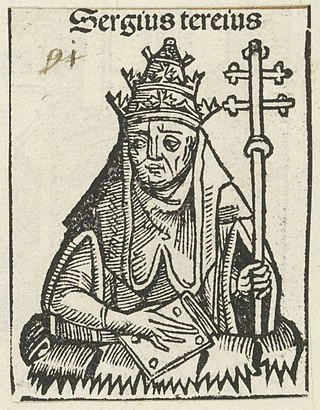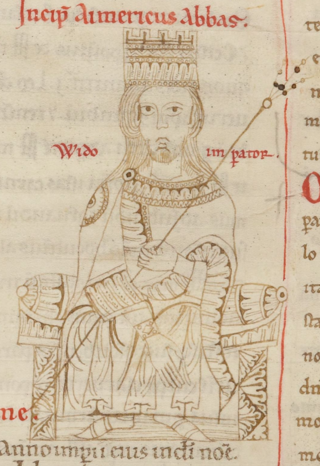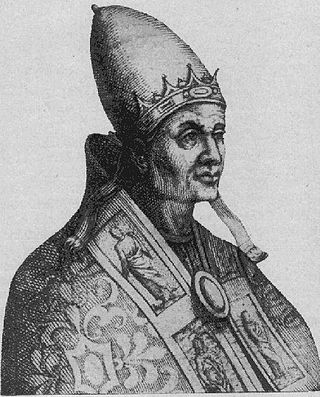Related Research Articles

Pope Agapetus II was the bishop of Rome and ruler of the Papal States from 10 May 946 to his death. A nominee of the princeps of Rome, Alberic II of Spoleto, his pontificate occurred during the period known as the Saeculum obscurum.
Pope Stephen VIII was the bishop of Rome and nominal ruler of the Papal States from 14 July 939 to his death. His pontificate occurred during the Saeculum obscurum, when the power of popes was diminished by the ambitious counts of Tusculum, and was marked by the conflict between his patron, Alberic II of Spoleto, and King Hugh of Italy.

Pope Sergius III was the bishop of Rome and nominal ruler of the Papal States from 29 January 904 to his death. He was pope during a period of violence and disorder in central Italy, when warring aristocratic factions sought to use the material and military resources of the papacy. At the behest of Theophylact I of Tusculum, Sergius seized the papal throne from Antipope Christopher, who in turn had deposed Pope Leo V. Sergius' reign was subsequently marked by Theophylact's influence. As pope, Sergius continued many ecclesiastical controversies of his predecessors, including conflict over Pope Formosus' legacy, annulling all ordinations made by the late pope, and the filioque controversy with eastern patriarchs. His pontificate was similarly marked by temporal conflicts, with Sergius' refusal to crown Berengar I of Italy as Holy Roman Emperor, and his support of Byzantine Emperor Leo VI the Wise's fourth marriage. Sergius also saw the restoration of the Lateran Palace.
Pope Leo V was the bishop of Rome and nominal ruler of the Papal States from July 903 to his death in February 904. He was pope immediately before the period known as the Saeculum obscurum, when popes wielded little temporal authority.

Marozia, born Maria and also known as Mariuccia or Mariozza, was a Roman noblewoman who was the alleged mistress of Pope Sergius III and was given the unprecedented titles senatrix ("senatoress") and patricia of Rome by Pope John X.
Pope John XII, born Octavian, was the bishop of Rome and ruler of the Papal States from 16 December 955 to his death in 964. He was related to the counts of Tusculum, a powerful Roman family which had dominated papal politics for over half a century. He became pope in his late teenage years or early twenties. In 960, he clashed with the Lombards to the south. Unable to control Rome easily, he sought help from King Otto I of Germany and crowned him emperor. John XII's pontificate became infamous for the alleged depravity and worldliness with which he conducted his office. He soon fell out with Otto, but died before Otto succeeded in his attempt to depose him.
Pope John XI was the bishop of Rome and nominal ruler of the Papal States from March 931 to his death. The true ruler of Rome at the time was his mother, Marozia, followed by his brother Alberic II. His pontificate occurred during the period known as Saeculum obscurum.
Pope John X was the bishop of Rome and nominal ruler of the Papal States from March 914 to his death. A candidate of the counts of Tusculum, he attempted to unify Italy under the leadership of Berengar of Friuli, and was instrumental in the defeat of the Saracens at the Battle of Garigliano. He eventually fell out with Marozia, who had him deposed, imprisoned, and finally murdered. John’s pontificate occurred during the period known as the Saeculum obscurum.

Saeculum obscurum, also known as the Pornocracy or the Rule of the Harlots, was a period in the history of the Papacy during the first two-thirds of the 10th century, following the chaos after the death of Pope Formosus in 896 which saw seven or eight papal elections in as many years. It began with the installation of Pope Sergius III in 904 and lasted for sixty years until the death of Pope John XII in 964. During this period, the popes were influenced strongly by a powerful and allegedly corrupt aristocratic family, the Theophylacti, and their relatives and allies. The era is seen as one of the lowest points of the history of the papal office.

Theophylact I was a medieval count of Tusculum who was the effective ruler of Rome from around 905 through to his death in 924. His descendants controlled the papacy for the next 100 years.

Theodora was a senatrix and serenissima vestaratrix of Rome. Theodora was married to Theophylact I, Count of Tusculum. The couple shared effective rulership of Rome between 905 and her death in 916.

Lambert was the King of Italy from 891, Holy Roman Emperor, co-ruling with his father from 892, and Duke of Spoleto and Camerino from his father's death in 894. He was the son of Guy III of Spoleto and Ageltrude, born in San Rufino. He was the last ruler to issue a capitulary in the Carolingian tradition.

Guy III of Spoleto was the margrave of Camerino from 880 and then duke of Spoleto and Camerino from 883. He was crowned king of Italy in 889 and emperor in 891. He died in 894 while fighting for control of the Italian Peninsula.
The Battle of Garigliano was fought in 915 between Christian forces and the Saracens. Pope John X personally led the Christian forces into battle. The aim was to destroy the Arab fortress on the Garigliano River, which had threatened central Italy and the outskirts of Rome for nearly 30 years.
Guy was the son of Adalbert II of Tuscany with Bertha, daughter of Lothair II of Lotharingia.
Gregory I was the Count of Tusculum sometime between 954 and 1012. Consul et dux 961, vir illustrissimus 980, praefectus navalis 999. He was the son of Alberic II, and Alda of Vienne. His half-brother was Pope John XII.
Alberic III was the Count of Tusculum, along with Galeria, Preneste, and Arce, from 1024, when his brother the count Roman was elected Pope John XIX, until his own death. He was a son of Gregory I and Maria, brother of Popes Benedict VIII and John XIX, and brother-in-law of Thrasimund III of Spoleto.

The Tusculan Papacy was a period of papal history from 1012 to 1048 where three successive relatives of the counts of Tusculum were installed as pope.
The Synod of Rome (963) was a possibly uncanonical synod held in St. Peter's Basilica from 6 November until 4 December 963, under the authority of the Holy Roman Emperor, Otto I to depose Pope John XII. The events of the synod were recorded by Liutprand of Cremona.
References
- ↑ Hinson, E. Glenn. The Church Triumphant: A History of Christianity Up to 1300, Mercer University Press, 1995, ISBN 9780865544369 p. 358
- ↑ Williams, George L., Papal Genealogy: The Families and Descendants Of The Popes (2004), p. 11
- 1 2 Mann, Horace K., The Lives of the Popes in the Early Middle Ages, Vol. IV: The Popes in the Days of Feudal Anarchy, 891-999 (1910), pp. 154–155
- ↑ Squatriti, Paolo. "Garigliano, Battle of", Medieval Italy: an Encyclopedia, (Christopher Kleinhenz, ed.), Routledge, 2004, ISBN 9781135948801, p. 398
- ↑ Mann, Horace K., The Lives of the Popes in the Early Middle Ages, Vol. IV: The Popes in the Days of Feudal Anarchy, 891–999 (1910), pgs. 199–200
- ↑ Drocourt, Nicolas; Kolditz, Sebastian, A Companion to Byzantium and the West, 900-1204 (2021), pgs. 159-160
- ↑ Gibbon, Edward, Milman, H. H., The History of the Decline and Fall of the Roman Empire, with Notes Vol. 3 (1841), pg. 518
- ↑ Mann, Horace. "Pope Sergius III." The Catholic Encyclopedia Vol. 13. New York: Robert Appleton Company, 1912. 23 September 2017